Chocolate Chip Sea Star, Nidorellia armata
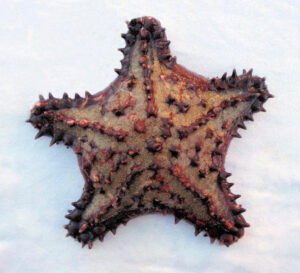
 Chocolate Chip Sea Star, Nidorellia armata. Sea star courtesy of the commercial fishermen of the greater Los Cabos area, Baja California Sur, July 2009. Wingspan: 12.5 cm (4.9 inches).
Chocolate Chip Sea Star, Nidorellia armata. Sea star courtesy of the commercial fishermen of the greater Los Cabos area, Baja California Sur, July 2009. Wingspan: 12.5 cm (4.9 inches).
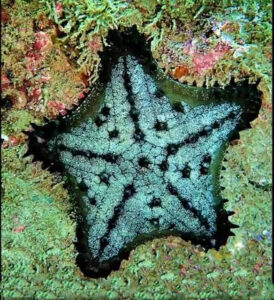
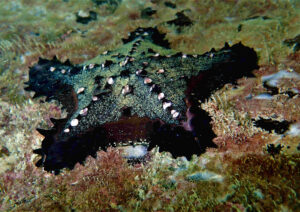
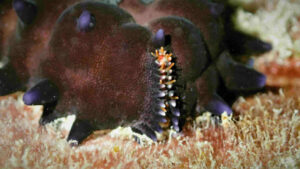 Chocolate Chip Sea Star, Nidorellia armata. Underwater photographs taken within Zihuatanejo Bay, Guerrero, March 2018. Photographs courtesy of Ron Woheau, Zihuatanejo.
Chocolate Chip Sea Star, Nidorellia armata. Underwater photographs taken within Zihuatanejo Bay, Guerrero, March 2018. Photographs courtesy of Ron Woheau, Zihuatanejo.
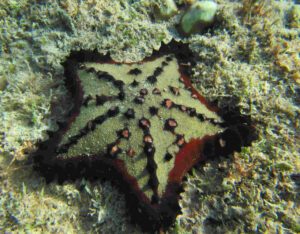 Chocolate Chip Sea Star, Nidorellia armata. Underwater photograph taken in coastal waters in the greater Los Cabos area, Baja California Sur, October 2019. Photograph courtesy of Bob Hillis, Ivins, Utah.
Chocolate Chip Sea Star, Nidorellia armata. Underwater photograph taken in coastal waters in the greater Los Cabos area, Baja California Sur, October 2019. Photograph courtesy of Bob Hillis, Ivins, Utah.
 Chocolate Chip Sea Star, Nidorellia armata. Underwater photograph taken in coastal waters off Isle Coronado, Baja California Sur, May 2023. Photograph courtesy of Dr. Tom Bartol, Carlsbad, California.
Chocolate Chip Sea Star, Nidorellia armata. Underwater photograph taken in coastal waters off Isle Coronado, Baja California Sur, May 2023. Photograph courtesy of Dr. Tom Bartol, Carlsbad, California.
Phylogeny: The Chocolate Chip Sea Star, Nidorellia armata (Gray, 1840), is a member of the Oreasteridae Family of Cushion Starfish, and is known in Mexico as estrella de chispas de chocolate. There are three global members of the Nidorellia Genus.
Morphology: The Chocolate Chip Sea Star has a thick and inflated disc, with very short, thick arms that almost appear to be webbed. The aboral surface may be cream, gray, greenish, or tan. They have dark brown, conical spines (resembling chocolate chips) scattered around the disc, and a row of these spines along the center of each arm. Ambulacral grooves with suckered tube feet are visible on the ventral side of the arms. The disc margin may be dark brown, orange brown, or reddish brown. The Chocolate Chip Sea Stars reach a maximum of 15 cm (5.9 inches) in diameter.
Habitat and Distribution: The Chocolate Chip Sea Star is found on cobbles, rocky reefs, and occasionally on sand. They feed on algae, echinoderms, and other small invertebrates. They live in the lower intertidal zone, and to a depth of 73 m (240 feet). The Chocolate Chip Sea Star is a resident of all Mexican waters of the Pacific with the exception that they are absent from Magdalena Bay, Baja California Sur, northward along the central and northwest coasts of Baja.
Diet: The Chocolate Chip Sea Star feeds on both benthic algae and sessile invertebrates.
Ecosystem Interactions: The commensal Periclimenes soror, or the Sea Star Shrimp, is often found in association with the Chocolate Chip Sea Star, living on the ventral side and feeding on the mucus secreted by the sea star.
Human Impact: The Chocolate Chip Sea Star is utilized by the aquarium trade on a nominal level.
Common Confusion: Protoreaster nodosus is sometimes referred to as the Chocolate Chip Sea Star but this species tends to have a red or brown aboral surface with large horns covering the central disk. In comparison, the spikes of Nidorellia armata are of more uniform size across the body.
Synonyms: Goniodiscus armata, Goniodiscus conifer, Goniodiscus michelini, Goniodiscus stella, Nidorellia michelini, Oreaster armatus, Pentaceros armatus.